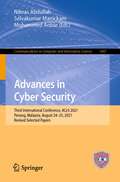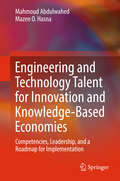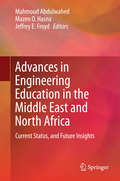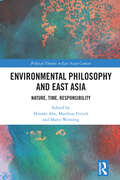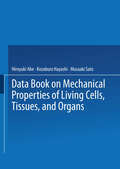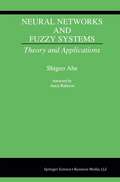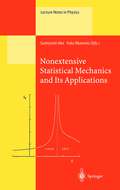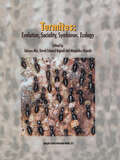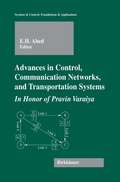- Table View
- List View
Advances in Cyber Security: Third International Conference, ACeS 2021, Penang, Malaysia, August 24–25, 2021, Revised Selected Papers (Communications in Computer and Information Science #1487)
by Nibras Abdullah Selvakumar Manickam Mohammed AnbarThis book presents refereed proceedings of the Third International Conference on Advances in Cyber Security, ACeS 2021, held in Penang, Malaysia, in August 2021. The 36 full papers were carefully reviewed and selected from 92 submissions. The papers are organized in the following topical sections: Internet of Things, Industry 4.0 and Blockchain, and Cryptology; Digital Forensics and Surveillance, Botnet and Malware, DDoS, and Intrusion Detection/Prevention; Ambient Cloud and Edge Computing, SDN, Wireless and Cellular Communication; Governance, Social Media, Mobile and Web, Data Privacy, Data Policy and Fake News.
Conserving Biocultural Landscapes in Malaysia and Indonesia for Sustainable Development
by Saiful Arif Abdullah Amin Setyo Leksono Sun-Kee HongThis book presents perspective on the importance of natural and cultural relationships for conserving bio-cultural landscapes. It explores the approaches and concepts used to conserve bio-cultural landscapes in Malaysia and Indonesia. The book highlights the importance of bio-cultural landscape in sustainable development framework and its link to sustainable development goals are also included. It fills the gap in literature with special focus on this region. The book is of interest to teachers, researchers, climate change scientists, conservationists, capacity builders and policymakers. Also it serves as additional reading material for undergraduate and graduate students of ecology, and environmental sciences. National and international environmental scientists, policy makers also find this to be a useful read.
Structural Integrity Cases in Mechanical and Civil Engineering (Structural Integrity #23)
by Shahrum Abdullah Salvinder Singh Karam Singh Noorsuhada Md NorThis book covers most of the damage mechanism in the scope of mechanical engineering and civil engineering. The failure pattern of various materials and structures is mainly discussed. The sub-topics covers fatigue damage, fatigue crack initiation and propagation, life prediction techniques, computational fracture mechanics, dynamic fracture, damage mechanics and assessment, non-destructive test (NDT), concrete failure assessment, failure on soil structures, structural durability and reliability, structural health monitoring, construction damage recovery, and any relevant topics related to failure analysis.
Crop Improvement: Sustainability Through Leading-Edge Technology
by Siti Nor Abdullah Ho Chai-Ling Carol WagstaffThe book covers the latest development in the biosciences field covering key topics in crop improvement including ‘omic approaches to improving sustainable crop production, advancement in marker technology, strategies in genetic manipulation, crop quality and sustainability and plant microbe interaction detailing on proven technologies to address critical issue for agricultural sustainability which are beneficial for researchers and students. The book also includes aspects of preserving crops after harvest as this is a key factor in promoting sustainable crop quality in terms of addressing waste, choosing the appropriate packaging and moving crops through the food and industrial supply chain. An important strategy to overcome the challenges in providing food for the world population in a sustainable manner is through concerted efforts by crop scientists to embrace new technologies in increasing yield, quality and improving food safety while minimizing adverse environmental impact of the agricultural activities. Most of the proven molecular and genetic technologies in crop science have been tested and verified in model plants such as Arabidopsis and tomato. The technologies, when deployed on various plant species of importance for human nutrition and industrial applications, including cereals, vegetables, fruits, herbs, fibre and oil crops, face many challenges, not only due to their longer life cycle but many other physiological and environmental factors affecting yield and quality of plant products. Furthermore, major impacts on crop production due to catastrophic diseases and global climate change needs urgent and innovative solutions. Therefore a systematic approach, employing various leading-edge technologies that enable the functional elucidation of key pathway genes via ‘omics tools, genome wide association with desired phenotypes and development of cost effective and practicable molecular tools for selection, is vital. The International Conference on Crop Improvement was held to address these and other pressing issues. This volume summarizes the keynote presentations from the meeting and highlights addition discussions that are critical to crop improvement in a challenging time.
Polyvinyl Alcohol/Halloysite Nanotube Bionanocomposites as Biodegradable Packaging Materials
by Zainab Waheed Abdullah Yu DongThis book focuses on the preparation and characterisation of polyvinyl alcohol (PVA)/ halloysite nanotube (HNT) bionanocomposite films with different HNT contents for potential use in food packaging. It examines the effect of material composition and nanofiller content on mechanical, thermal and optical properties in relation to their morphological structures, and also comprehensively describes the water resistance, biodegradation and migration rates of such bionanocomposites, as well as their barrier properties in terms of water vapour transmission, and water vapour, air and oxygen permeabilities. Further, this book discusses the use of Nielsen model and Cussler model to predict the relative permeability of bionanocomposites, demonstrating that Nielsen model is more effective and in better agreement with experimental data obtained. Lastly, it discusses the application of bionanocomposite films in food packaging to prolong the shelf life of freshly cut avocados and peaches.
Industry Integrated Engineering and Computing Education: Advances, Cases, Frameworks, and Toolkits for Implementation
by Mahmoud Abdulwahed Abdelaziz Bouras Laurent VeillardThis book introduces recent global advances and innovations in industry integrated engineering and computing education to academics, program managers, department heads, and deans, and shares with readers a critical perspective on future potentials in industry integrated engineering education. It covers topics and issues such as integrated engineering and computing education, part-time engineering masters programs, secure BIM learning, ethics, and IT workforce development. The book concludes with detail information on summarizing and extracting different frameworks, cases, and models into a practitioner toolkit, along with pragmatic recommendations for engineering education academics to quickly utilize, adopt, and adapt the toolkits for their own curricular development activities.
Engineering and Technology Talent for Innovation and Knowledge-Based Economies: Competencies, Leadership, and a Roadmap for Implementation
by Mahmoud Abdulwahed Mazen O. HasnaThis book introduces and analyzes the models for engineering leadership and competency skills, as well as frameworks for industry-academia collaboration and is appropriate for students, researchers, and professionals interested in continuous professional development. The authors look at the organizational structures of engineering education in knowledge-based economies and examine the role of innovation and how it is encouraged in schools. It also provides a methodological framework and toolkit for investigating the needs of engineering and technology skills in national contexts. A detailed empirical case study is included that examines the leadership competencies that are needed in knowledge-based economies and how one university encourages these in their program. The book concludes with conceptual modeling and proposals of specific organizational structures for implementation in engineering schools, in order to enable the development of necessary skills for future engineering graduates.
Advances in Engineering Education in the Middle East and North Africa: Current Status, and Future Insights
by Mahmoud Abdulwahed Mazen O. Hasna Jeffrey E. FroydThis book provides a collection of the latest advances in engineering education in the Middle East and North Africa (MENA) region and sheds insights for future development. It is one of the first books to address the lack of comprehensive literature on undergraduate engineering curricula, and stimulates intellectual and critical discourse on the next wave of engineering innovation and education in the MENA region. The authors look at recent innovations through the lens of four topics: learning and teaching, curriculum development, assessment and accreditation, and challenges and sustainability. They also include analyses of pedagogical innovations, models for transforming engineering education, and methods for using technological innovations to enhance active learning. Engineering education topics on issues such as construction, health and safety, urban design, and environmental engineering in the context of the MENA region are covered in further detail. The book concludes with practical recommendations for implementations in engineering education. This is an ideal book for engineering education academics, engineering curriculum developers and accreditation specialists, and deans and leaders in engineering education.
Interphases and Mesophases in Polymer Crystallization II (Advances in Polymer Science #181)
by A. Abe Auriemma S. Bracco A. Comotti P. Corradini W.H.de Jeu C. De Rosa H. Furuya T. Hiejima Y. Kobayashi L. Li R. Simonutti P. Sozzani Z. ZhouViscoelasticity Atomistic Models Statistical Chemistry (Advances in Polymer Science #152)
by Akihiro Abe Ann-Christine Albertsson Karel Dusek Jan Genzer Shiro Kobayashi Kwang-Sup Lee Ludwik Leibler Timothy E. Long Ian Manners Martin Möller Eugene M. Terentjev Maria J. Vicent Brigitte Voit Ulrich WiesnerWith contributions by numerous experts
Biopolymers: Lignin, Proteins, Bioactive Nanocomposites (Advances in Polymer Science #232)
by Akihiro Abe Karel Dusek Shiro Kobayashi-Lignin Structure, Properties, and Applications By H. Hatakeyama, T. Hatakeyama -Tensile Mechanics of α-Helical Coil Springs By A. Ikai -Bioactive Polymer/Hydroxyapatite (Nano)composites for Bone Tissue Regeneration By K. Pielichowska, S. Blazewicz
Environmental Philosophy and East Asia: Nature, Time, Responsibility (Political Theories in East Asian Context)
by Hiroshi Abe Matthias Fritsch Mario WenningThis book explores the contributions of East Asian traditions, particularly Buddhism and Daoism, to environmental philosophy in dialogue with European philosophy. It critically examines the conceptions of human responsibility toward nature and across time presented within these traditions.The volume rethinks human relationships to the natural world by focusing on three main themes: Daoist and Eurodaoist perspectives on nature, human responsibility toward nature, and Buddhist perspectives on life and nature. By way of discussing East Asian traditions and European thinkers, this collection reveals that the impact of humanity on the environment is shaped not only by distinctive modes of economic production, but also by cultural beliefs and practices. Representing a unique constellation of environmental and intercultural philosophy, the contributions present systematic approaches to the global need for cultivating environmental responsibility across cultures and generations to address the political, ethical, and aesthetic challenges arising from humanity’s transformative impact on the natural world.Presenting a critical re-evaluation of human relationships to the natural world in dialogue with East Asian traditions, this will be a valuable resource for students and scholars of Philosophy, Environmental Studies and Asian Studies.
Environmental Philosophy and East Asia: Nature, Time, Responsibility (Political Theories in East Asian Context)
by Hiroshi Abe Matthias Fritsch Mario WenningThis book explores the contributions of East Asian traditions, particularly Buddhism and Daoism, to environmental philosophy in dialogue with European philosophy. It critically examines the conceptions of human responsibility toward nature and across time presented within these traditions.The volume rethinks human relationships to the natural world by focusing on three main themes: Daoist and Eurodaoist perspectives on nature, human responsibility toward nature, and Buddhist perspectives on life and nature. By way of discussing East Asian traditions and European thinkers, this collection reveals that the impact of humanity on the environment is shaped not only by distinctive modes of economic production, but also by cultural beliefs and practices. Representing a unique constellation of environmental and intercultural philosophy, the contributions present systematic approaches to the global need for cultivating environmental responsibility across cultures and generations to address the political, ethical, and aesthetic challenges arising from humanity’s transformative impact on the natural world.Presenting a critical re-evaluation of human relationships to the natural world in dialogue with East Asian traditions, this will be a valuable resource for students and scholars of Philosophy, Environmental Studies and Asian Studies.
Data Book on Mechanical Properties of Living Cells, Tissues, and Organs
by Hiroyuki Abe Kozaburo Hayashi Masaaki SatoA research project entitled Biomechanics of Structure and Function of Living Cells, Tissues, and Organs was launched in Japan in 1992. This data book presents the original, up-to-date information resulting from the research project, supplemented by some of the important basic data published previously. The aim of collecting the information is to offer accurate and useful data on the mechanical properties of living materials to biomechanical scientists, biomedical engineers, medical scientists, and clinicians. The data are presented in graphs and tables (one type of data per page) arranged in an easily accessible manner, along with details of the origin of the material and the experimental method. Together with its two companion volumes, Biomechanics: Functional Adaptation and Remodeling and Computational Biomechanics, the Data Book on Mechanical Properties of Living Cells, Tissues, and Organs is a timely and valuable contribution to the rapidly growing field of biomechanics.
Roots: The Dynamic Interface between Plants and the Earth (Developments in Plant and Soil Sciences #101)
by Jun J. AbeThe root is the organ that functions as the interface between the plant and the earth environment. Many human management practices involving crops, forests and natural vegetation also affect plant growth through the soil and roots. Understanding the morphology and function of roots from the cellular level to the level of the whole root system is required for both plant production and environmental protection. This book is at the forefront of plant root science (rhizology), catering to professional plant scientists and graduate students. It covers root development, stress physiology, ecology, and associations with microorganisms. The chapters are selected papers originally presented at the 6th Symposium of the International Society of Root Research, where plant biologists, ecologists, soil microbiologists, crop scientists, forestry scientists, and environmental scientists, among others, gathered to discuss current research results and to establish rhizology as a newly integrated research area.
Measurement Techniques and Practices of Colloid and Interface Phenomena
by Masahiko AbeThis book is a manual of measurement of colloids and interfaces designed especially for new researchers who have just begun research on these topics. The book is written by active researchers in the field of colloids and interfacial chemistry, based on the practical experience of the authors. In each chapter, the key points of measurement, how to analyze data correctly, points to be careful about, and merits of a particular method are concisely explained from the point of view of the readers. Not only in industries such as cosmetics and pharmaceuticals but also in academic studies of nanotechnology, correct understanding of colloid and interface phenomena is vital because the properties of these items, however small, are affected by the nature of interfaces. This book will be particularly useful for researchers who are not yet fully confident of the measurement techniques that are clearly explained here.
'Cherry' Ingram: The Englishman Who Saved Japan’s Blossoms
by Naoko AbeThe irresistible story of Japanese cherry blossoms, threatened by political ideology and saved by an unknown EnglishmanCollingwood Ingram, known as ‘Cherry’ for his defining obsession, was born in 1880 and lived until he was a hundred, witnessing a fraught century of conflict and change. After visiting Japan in 1902 and 1907 and discovering two magnificent cherry trees in the garden of his family home in Kent in 1919, Ingram fell in love with cherry blossoms, or sakura, and dedicated much of his life to their cultivation and preservation.On a 1926 trip to Japan to search for new specimens, Ingram was shocked to see the loss of local cherry diversity, driven by modernisation, neglect and a dangerous and creeping ideology. A cloned cherry, the Somei-yoshino, was taking over the landscape and becoming the symbol of Japan's expansionist ambitions.The most striking absence from the Japanese cherry scene, for Ingram, was that of Taihaku, a brilliant ‘great white’ cherry tree. A proud example of this tree grew in his English garden and he swore to return it to its native home. Multiple attempts to send Taihaku scions back to Japan ended in failure, but Ingram persisted.Over decades, Ingram became one of the world’s leading cherry experts and shared the joy of sakura both nationally and internationally. Every spring we enjoy his legacy. ‘Cherry’ Ingram is a portrait of this little-known Englishman, a story of Britain and Japan in the twentieth century and an exploration of the delicate blossoms whose beauty is admired around the world.
Neural Networks and Fuzzy Systems: Theory and Applications
by Shigeo AbeNeural Networks and Fuzzy Systems: Theory and Applications discusses theories that have proven useful in applying neural networks and fuzzy systems to real world problems. The book includes performance comparison of neural networks and fuzzy systems using data gathered from real systems. Topics covered include the Hopfield network for combinatorial optimization problems, multilayered neural networks for pattern classification and function approximation, fuzzy systems that have the same functions as multilayered networks, and composite systems that have been successfully applied to real world problems. The author also includes representative neural network models such as the Kohonen network and radial basis function network. New fuzzy systems with learning capabilities are also covered. The advantages and disadvantages of neural networks and fuzzy systems are examined. The performance of these two systems in license plate recognition, a water purification plant, blood cell classification, and other real world problems is compared.
Nonextensive Statistical Mechanics and Its Applications (Lecture Notes in Physics #560)
by Sumiyoshi Abe Yuko OkamotoNonextensive statistical mechanics is now a rapidly growing field and a new stream in the research of the foundations of statistical mechanics. This generalization of the well-known Boltzmann--Gibbs theory enables the study of systems with long-range interactions, long-term memories or multi-fractal structures. This book consists of a set of self-contained lectures and includes additional contributions where some of the latest developments -- ranging from astro- to biophysics -- are covered. Addressing primarily graduate students and lecturers, this book will also be a useful reference for all researchers working in the field.
Termites: Evolution, Sociality, Symbioses, Ecology
by Y. Abe David Edward Bignell T. HigashiThe book is a new compendium in which leading termite scientists review the advances of the last 30 years in our understanding of phylogeny, fossil records, relationships with cockroaches, social evolution, nesting, behaviour, mutualisms with archaea, protists, bacteria and fungi, nutrition, energy metabolism,population and community ecology, soil conditioning, greenhouse gas production and pest status.
New Trends in Nuclear Collective Dynamics: Proceedings of the Nuclear Physics Part of the Fifth Nishinomiya-Yukawa Memorial Symposium, Nishinomiya, Japan, October 25 and 26, 1990 (Springer Proceedings in Physics #58)
by Yasuhisa Abe Hisashi Horiuchi Kenichi Matsuyanagi"New Trends in Nuclear Collective Dynamics" emphasizes research toward understanding collective and statistical aspects of nuclear dynamics. Well-known lecturers from centers of nuclear research present reviews of recent developments. The topics covered are: -order and chaos in finite quantum systems -dissipation in heavy-ion collisions -collective motionsin warm nuclei -time-dependent mean-field theory with collision terms -nuclear fission and multi-dimensional tunneling -large-scale collective motion
Modelling Human-Flood Interactions: A Coupled Flood-Agent-Institution Modelling Framework for Long-Term Flood Risk Management (IHE Delft PhD Thesis Series)
by Yared Abayneh AbebeThe negative impacts of floods are attributed to the extent and magnitude of a flood hazard, and the vulnerability and exposure of natural and human elements. In flood risk management (FRM) studies, it is crucial to model the interaction between human and flood subsystems across multiple spatial, temporal and organizational scales. Models should address the heterogeneity that exists within the human subsystem, and incorporate institutions that shape the behaviour of individuals. Hence, the main objectives of the dissertation are to develop a modelling framework and a methodology to build holistic models for FRM, and to assess how coupled human-flood interaction models support FRM policy analysis and decision-making. To achieve the objectives, the study introduces the Coupled fLood-Agent-Institution Modelling framework (CLAIM). CLAIM integrates actors, institutions, the urban environment, hydrologic and hydrodynamic processes and external factors, which affect FRM activities. The framework draws on the complex system perspective and conceptualizes the interaction of floods, humans and their environment as drivers of flood hazard, vulnerability and exposure. The human and flood subsystems are modelled using agent-based models and hydrodynamic models, respectively. The two models are dynamically coupled to understand human-flood interactions and to investigate the effect of institutions on FRM policy analysis.
Modelling Human-Flood Interactions: A Coupled Flood-Agent-Institution Modelling Framework for Long-Term Flood Risk Management (IHE Delft PhD Thesis Series)
by Yared Abayneh AbebeThe negative impacts of floods are attributed to the extent and magnitude of a flood hazard, and the vulnerability and exposure of natural and human elements. In flood risk management (FRM) studies, it is crucial to model the interaction between human and flood subsystems across multiple spatial, temporal and organizational scales. Models should address the heterogeneity that exists within the human subsystem, and incorporate institutions that shape the behaviour of individuals. Hence, the main objectives of the dissertation are to develop a modelling framework and a methodology to build holistic models for FRM, and to assess how coupled human-flood interaction models support FRM policy analysis and decision-making. To achieve the objectives, the study introduces the Coupled fLood-Agent-Institution Modelling framework (CLAIM). CLAIM integrates actors, institutions, the urban environment, hydrologic and hydrodynamic processes and external factors, which affect FRM activities. The framework draws on the complex system perspective and conceptualizes the interaction of floods, humans and their environment as drivers of flood hazard, vulnerability and exposure. The human and flood subsystems are modelled using agent-based models and hydrodynamic models, respectively. The two models are dynamically coupled to understand human-flood interactions and to investigate the effect of institutions on FRM policy analysis.
Advances in Control, Communication Networks, and Transportation Systems: In Honor of Pravin Varaiya (Systems & Control: Foundations & Applications)
by Eyad H. AbedThis unified volume is a collection of invited articles on topics presented at the Symposium on Systems, Control, and Networks, held in Berkeley June 5–7, 2005, in honor of Pravin Varaiya on his 65th birthday. Varaiya is an eminent faculty member of the University of California at Berkeley, widely known for his seminal contributions in areas as diverse as stochastic systems, nonlinear and hybrid systems, distributed systems, communication networks, transportation systems, power networks, economics, optimization, and systems education. The book will serve as an excellent resource for practicing and research engineers, applied mathematicians, and graduate students working in such areas as communication networks, sensor networks, transportation systems, control theory, hybrid systems, and applications.
Magnetomicrofluidic Circuits for Single-Bioparticle Transport
by Roozbeh Abedini-NassabThis book highlights the current state of the art in magnetophoretic circuits and their use in the emerging field of single-cell analysis. This interdisciplinary topic involves many fields of science including cellular biology, drug screening, cancer research, personalized medicine, microfabrication, biomedical microdevices, and lab-on-a-chip. This book not only provides the required fundamental knowledge and background needed in magnetics and the circuit theory but also describes the idea of magnetophoretic circuits as well as the cutting-edge developed technologies. It provides a sufficient background in i) the required theory in magnetics, ii) SCAs in general, iii) the circuit theory, iv) the developed idea of the magnetophoretic circuits, v) the fabrication process and magnetic cell labeling techniques, vi) the magnetophoretic-based SCA tools, and vii) the bio-applications. Methods for performing simulations as well as designing, fabricating, and running experiments are explained. Author of the book is one of the inventors of some of the ideas and the author/co-author of some of the related articles in high-impact journals. The book appeals to the readers interested in clinical applications as well as the ones interested in its technical aspects. It is beneficial for researchers interested in the field of single-cell analysis from various disciplines including biomedical engineering, mechanical engineering, electrical engineering, materials science, and cellular biology.
